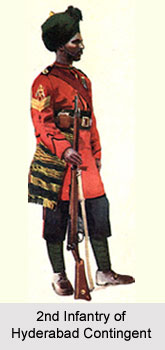 The 2nd Infantry of Hyderabad Contingent was an army infantry unit of the British East India Company. The Hyderabad Contingent was the army of the Nizam of Hyderabad. After the 1801 treaty, the Nizam of Hyderabad was obligated to maintain a military force at Hyderabad. The battalion was also designated as the Nizam`s Army and the Nizam`s Contingent. Later the contingent was incorporated in the Kumaon Regiment of the British Indian Army. The Nizam`s Army was amongst of the Presidency Armies in British India. After 1903, the presidency armies were united together to raise the British Indian Army. The 2nd Infantry of Hyderabad Contingent was also known as the 95th Russell`s Infantry.
The 2nd Infantry of Hyderabad Contingent was an army infantry unit of the British East India Company. The Hyderabad Contingent was the army of the Nizam of Hyderabad. After the 1801 treaty, the Nizam of Hyderabad was obligated to maintain a military force at Hyderabad. The battalion was also designated as the Nizam`s Army and the Nizam`s Contingent. Later the contingent was incorporated in the Kumaon Regiment of the British Indian Army. The Nizam`s Army was amongst of the Presidency Armies in British India. After 1903, the presidency armies were united together to raise the British Indian Army. The 2nd Infantry of Hyderabad Contingent was also known as the 95th Russell`s Infantry.
History of 2nd Infantry of Hyderabad Contingent
The infantry regiment was established by Sir Henry Russell in the year 1813 as the 2nd Battalion of the Russell Brigade for the Princely state of Hyderabad. It became a part of the armed force of Nizam of Hyderabad after signing of a treaty with the Governor General of India. The regiment was designated as the 2nd Infantry of Hyderabad Contingent in the year 1854. The army unit of British India was again renamed as the 95th Russell`s Infantry in 1903. Afterwards the military company became the Kumaon Regiment in 1945.
All the regiments of the British Indian Army were renumbered and re- grouped by the British Government of India after the end of First World War. As a result, multi battalion regiments of 4 to 6 battalions in each unit were formed by merging the several single battalion regiments. The 95th Russell`s Infantry was re-designated as the 10th (Training) Battalion 19th Hyderabad Regiment in the year 1922.
On 15th August 1947, the country achieved independence from the political and administrative domination of the British Empire in India. Accordingly, British India was divided by the Partition of India and the army was split between the newly formed states of the Union of India and the Dominion of Pakistan. The 2nd Infantry of Hyderabad Contingent was allocated to the modern Army of India.
Designations of 2nd Infantry of Hyderabad Contingent
The army unit held a various designations during its service in the British Indian Army, like the other regiments. These are listed below -
* 2nd Battalion of Sir Henry Russell`s Brigade in 1813
* 2nd Regiment of Infantry, Nizam`s Army in 1826
* 2nd Infantry of Hyderabad Contingent in 1854
* 95th Russell`s Infantry in 1903
* 10th (Training) Battalion 19th Hyderabad Regiment in 1922
* Kumaon Regiment in 1945
* Assigned to modern Indian Army in 1947



















